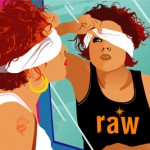Erika Rios. Sexuality and the Body as a Form of Liberation
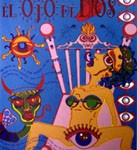 I am from New Jersey and am a sophomore at Princeton. My major is Latin American History and I am pursuing a certificate in the Program of Latin American Studies and a certificate in Contemporary European Politics. I am from New Jersey and am a sophomore at Princeton. My major is Latin American History and I am pursuing a certificate in the Program of Latin American Studies and a certificate in Contemporary European Politics. |
Sexuality and the Body as a Form of Liberation: A Critical Analysis of Art and Print as Resistance
Introduction
Favianna Rodriguez, a California-based Peruvian artist and activist, describes a two-fold purpose for her art. First, she uses it as a tool for resisting misogynistic, racist, and sex shaming ideology through the representation of Latin American women whom she calls “women of color.” Rodriguez creates, distributes, and popularizes her art as a grassroots-based effort to bring about social change through education, awareness, and discussion . Her work reshapes the non-white female identity as something limited and tyrannized by suffering and “made” beautiful through sexual liberation and active resistance of patriarchal oppression. The means for this resistance must originate from an entirely female foundation—a “beautifying” process of women strengthening women and taking proud ownership over their sexual desires. Rodriguez’s work argues for an understanding of female sexuality as something inseparable from the physical female form and the body as inseparable from female identity. A selection of three Rodriguez’s prints represent this “process” of liberation, from oppressed (Maquila) to self-discovery (Del Ojo No Se Escapa Nadie) to empowerment (I’m a slut. I vote).
Analysis of Prints
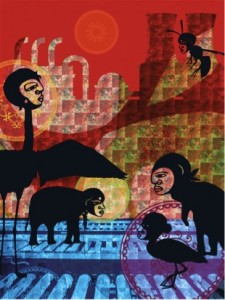
Favianna Rodriguez. Maquila.
One of Rodriguez’s famous prints, Maquila,is a response to the rampant femicide in the small city of Juárez, Mexico. . Since 2010, over 465 women were reported murdered in Ciudad Juárez, with a large majority of them raped and tortured (Rizzo, 2011). The 2010 wave of homicide is part of a tragic tradition of female slayings that has plagued Juárez for decades (Rizzo, 2011). In Maquila, Rodriguez juxtapositions the Mestizo Mexican women faces—detailed with passive and defeated expressions—with the bodies of animals. Their non-white profiles are highlighted through large lips and wider, rounder noses. Although there are five female figures in the print, each facing each other, they are all shown as isolated. No individual appears engaged with any of the other women. Instead, their eyes are trained downward, to the conveyer belt they sit upon. The lack of expression within them forces the viewer to wonder if the figures themselves know where they are.
Rodriguez describes the depiction of women as animals as a metaphor. Sitting atop the assembly line with the image of factory buildings in the background, these women have no control over themselves. The belt they are positioned on takes possession of their bodies and transforms them into products for other people’s use. Their lack of movement and blank eyes demonstrates a possession of their mind as well. What are these women trapped by? It is more than just the murderers of Juárez but rather the motivating logic behind the murders: that others have the right to take possession over the female body and, therefore, the female identity.
One of the main points of Rodriguez’s writing is the experience of shame trapping the expression of “true” womanhood. Rodriguez is arguing that women are constantly shamed for feeling or acting upon sexual urges and possessing sexualized bodies . Sara Ahmed’s work in “Shame Before Others: Cultural Politics of Emotion” analyzes shame as a physical sentiment (2004). The literal term defines “shame” as “covering.” The women’s bodies are not visible to the viewer, cloaked under the bodies of animals and hidden by the shame imposed upon them and, according to Ahmed (2004). This shame is what encourages women to distance themselves from their sexuality and agency (Ahmed 2004). It is, Rodriguez insists, “that constant negative voice that doesn’t let you flourish” (See Footnote 3 above). The figures on the conveyer belt have been trapped by a patriarchal society that makes claims over them based on their gender and sexuality. They remain trapped because of the guilt imposed upon them. Depicted as sedentary figures, there is no resistance in this piece—just passive submission to shame.
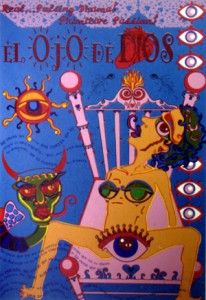
Favianna Rodriguez. El Ojo de Dios.
The second print, Del Ojo No Se Escapa Nadie, marks a progression towards female agency. The figure in this picture is shedding the “guilt” that comes with accepting her sexuality. The woman’s legs are spread open and her nude body is positioned on top of a bed. Rodriguez painted eyes the sexualized parts of her body—the vagina and breasts—as proof that the body and sexuality cannot be separated. The genitals replaced by eyes (the “windows into the soul”) symbolize the union between sexuality and the body with female identity. Ojo shows a woman ready to engage in sex and the vantage point of the print allows the viewer to see the women in the same way her sexual partner would. The title of the piece (No One Can Escape the Eyes) elevates the eye to a constant presence—the mind and personality of the sexually liberated woman cannot be removed from sex. This woman’s partner may have sex with her, but it is because of her own control over her own body and self. Furthermore, When Rodriguez refers to this eye as “God’s Eye,” she is using religion to promote sexuality as something natural and correct—a reclaiming of the sexuality as part of God’s own creation and criticism on the “shaming” culture that represses God’s will for women.
Unlike the immobile women in Maquila, the woman in Ojo is in movement. She curls her tongue upward and holds her own legs up and off the bed. She has taken action to shed her guilt and discover her sexual freedom. Rodriguez’s work is devoted to the idea of finding “the self” through female sexuality. Much of her own autobiographical work relates to this experience of sexual liberation, which Rodriguez coins as “slut positivity” . She describes her own sexual liberation as a “journey…to shed that shame and embrace the complex creature I am” (See Footnote 3 above). Rodriguez embraces this “embrace” as “feeling like a slut who just came out [of] the closet. I felt good, empowered, able to be my full self…even if that…made others uncomfortable” (see Footnote 4 above). The process of owning up to female sexuality, in other words, is inadvertently the same process of discovering the “true” identity.
How does a woman obtain “beauty” now that she has embraced her sexuality? Of the body, Rodriguez writes, “My temple that is my body is my lifelong container…I’m understanding how it rebuilds it self ” . In this case, the “container” mediates the woman’s sexuality and flourishes under sexual (and thus bodily) freedom, but how does the body “rebuild it self” in beauty? Perhaps most revealing is blog entry about International Women’s Day in 2006 . In trying to dispel media and consumer propelled notions of beauty, Rodriguez tries to show the “beauty identity.” She writes that it is, “authentic, real, powerful, strong, courageous, exposed, vulnerable – peeling away layers to expose the truest self” (See footnote 6 above). Beauty, in other words, is a relentless process that involves the elimination of shame and the acceptance and protection of the sexually liberated self that emerges. By tying sexuality and the body together and using sexuality as resistance, Rodriguez also positions the physical form, by extension, as a form of resistance.
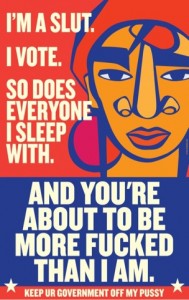
Favianna Rodriguez. I’m a Slut. I Vote.
Rodriguez acknowledges that the body is naturally potent. She quotes “The Pussy Power Manifesto” in her blog, writing, “the pussy is powerful” . Rodriguez’s third piece embodies this theme. Inspired by conservative political movements to limit women’s access to health care and sexual education, the print, I’m a slut. I vote., reveals a portrait of a non-white woman positioned against words of resistance. Free from the oppression of Maquila and sexually awakened like in Ojo, this woman’s resistance to patriarchal subjugation makes her beautiful. The woman in I’m a slut. bears none of the shame that traps the first figures. Instead, she stares directly into the eyes of the viewer, unashamed and strong. Her head, unlike the other prints, is not in profile but facing forward fiercely. The words she is endorsing are fighting words. She takes her sexuality and openly celebrates it—“I’m a slut”—and then uses it to grant herself agency and a voice—“I vote. So does everyone I sleep with”—that is transformed into resistance—“And you’re about to be more fucked than I am. Keep ur government off my pussy.”
Conclusion: Methods of Representation
Rodriguez’s work has two problematic gaps. First, although all three pictures depict non-white Latin American women, Rodriguez usually refers to these women as “POC (people of color)” or “WOC (women of color)” (See footnote 6 above). A myriad of terms to describe the different types of “non-white” exist within Latin America and, although Rodriguez does operate within both Latin America and the United States (See footnote 1 above), she identifies herself as a “WOC”—an expression not found within Latin America . Favianna Rodriguez is in fact very concerned about race within Latin American women. In her blog entry entitle “Should feminist art about women & health include sex work, masturbation, polyamory, & porn? EveryBody exhibit opens in MN” (see footnote 8 above) she expresses her intentions of adding to the existing gender and race studies. Does that fall flat in practice?
The origin of the “people of color” term is grounded in white, European history. The word first appears in the late 18thcentury in reference to slavery and moves to the U.S through British colonization (Safire 1988). It was popularized as part of the Civil Rights movement through Martin Luther King’s speech, “I have a dream,” where Dr. King referred to African Americans as “citizens of color” (Safire, 1988). What place does this “white” term have in Latin American discourse? In the advice she gives on her blog for aspiring activist artists, Rodriguez gives two recommendations. The first is that, “posters…are often able to draw comparisons between the society we DO and DON’T want” and the second is that “their messages are often a call for collective identity” . By imposing the “POC/WOC” label on women who are not “women of color” but in fact identify with Latin American terms, Favianna Rodriguez also dilutes the problematic aspects of being a Latin American woman and equates it with the same problems felt in North America and other white-countries where “people of color” exist in minorities. Doing so does not educate on the struggles of racism and misogyny is Latin America but instead misinforms the viewer by pushing a “collective identity” dominated by non-Latin American struggle. It also enforces the American/European ideal (“the society we DO want” that is presented in her posters) upon people who have historically had to operate under their colonizing thumb.
The second problem with her work is the audience it reaches. The art review in data 4.2 praises Rodriguez’s edgy work but also points out its limitations. These brazen images do not educate those who are uneducated about the Latin American female’s struggle but hearten those who are already enraged by it. An understanding of sexual liberation, reproductive rights movements, and the femicide in Juárez was necessary in deconstructing these three prints. As Utine’s review puts it, “The ones who getit, already got it” . Additionally, written mostly in English and seen mostly through computers or art galleries, Rodriguez’s artwork and workshops are mostly unavailable to the marginalized women she is often representing. Although Rodriguez has travelled to Latin America—even to Mexico to discuss the femicide in Juárez (see data file 10 above)—her lectures in Universities still neglect a lot of her target audience.
In conclusion, Rodriguez does a successful job of demonizing “sex shaming” and encouraging women to empower themselves. Her notion of “beauty” as something achievable through sexual freedom and resistance makes it reasonably accessible and refreshing within the existing feminine studies discourse. Her treatment of resistance is also founded on positive ideals of body acceptance and celebration but what does this do for the Latin American women currently living under conditions of sexual oppression and misogyny? Rodriguez provides interesting food for thought for the POC/WOC people she identifies with but she misses the mark when it comes to effecting changes within the Latin American community.
Bibliography
Ahmed, S. (2004) “Shame Before Others” in The Cultural Politics of Emotions. (London and New York: Routledge), pp 101-121.
Hobson, J. (2001) “The ‘Batty’ Politic; Towards an Aesthetic of the Black Female Body,” Venus in the dark: blackness and beauty in popular culture, 629-648
Jones, M. (2008) “Skintight: an anatomy of Cosmetic Surgery” Space and Place: Globalization and Mediascapes. 32-58
“Las Muertas de Juárez Demandan Justicia” (2010), http://www.politicalgraphics.org/exhibitions/28women_juarez.html Accessed May 14, 2012,
Reischer, E. and Koo, K. (2004) “The Body Beautiful: Symbolism and Agency in the Social World,” Annual Review of Anthropology. (33) 297-315.
Rizzo, C. (2011) “No End to Femicide in Ciudad Juarez.” Foreign Policy Association, http://foreignpolicyblogs.com/2011/02/22/no-end-to-femicide-in-ciudad-juarez/. Accessed May 13, 2012.
Rodriguez, F. (2011) “A list of reasons why political posters are vital tools in social movements” Favianna Rodriguez, http://www.faviannarodriguez.typepad.com. Accessed May 14, 2012
Rodriguez, F. “Artist Statement.” Favianna Rodriguez, http://www.favianna.com/statement/index.php. Accessed May 133, 2012
Rodriguez, F. (1999) Del Ojo No Se Escapa Nadie (Online Image). Available from: http://www.favianna.com/port_prints/prints3.php. Accessed April 20, 2012
Rodriguez, F (2011) “I am an Onion with Many Layers to Peel.” Favianna Rodriguez. http://www.faviannarodriguez.typepad.com. Accessed May 14, 2012.
Rodriguez, F. (2012) I’m a Slut. I Vote (Online Image). Available from: http://favianna.typepad.com/faviannacom_art_activism/2012/03/take-ur-conservative-laws-and-go-f-yourself-3-new-posters-for-the-woman-bashing-year.html. Accessed April 20, 2012.
Rodriguez, F. (2011) “I’m miserable, happy, and in pain all at the same time.” Favianna Rodriguez. http://favianna.typepad.com/faviannacom_art_activism/2011/11/im-miserable-happy-and-in-pain-all-at-the-same-time.html. Accessed May 10th, 2012.
Rodriguez, F. (2006) “International Women’s Day”. Favianna Rodriguez. http://favianna.typepad.com/faviannacom_art_activism/2006/02/index.html. Accessed May 14, 2012
Rodriguez, F. Maquila (Online Image). Available from: http://www.justseeds.org/favianna_rodriguez/19maquila.html. Accessed April 20, 2012.
Rodriguez, F. Online Store Item Description for ‘Maquila.’ Favianna Rodriguez. http://favianna.flyingcart.com/index.php?p=detail&pid=19&cat_id=. Accessed May 14, 2012.
Rodriguez, F. (2011) “Sex-Positive Shop, Black-Woman owned, to open in my city!”, Favianna Rodriguez, http://favianna.typepad.com/faviannacom_art_activism/2011/01/sex-positive-shop-black-woman-owned-to-open-in-my-city-thats-what-im-talkign-bout.html. Accessed May 13, 2012
Rodriguez, F. (2011) “Should feminist art about women & health include sex work, masturbation, polyamory, (sic) & porn?” Favianna Rodriguez, http://favianna.typepad.com/faviannacom_art_activism/2011/04/everybody-a-feminist-perspective-on.html. Accessed May 14, 2012
Rodriguez, F. (2011) “Some open, non-censored thoughts about being an artist slut and why it’s important.” Favianna Rodriguez. http://favianna.typepad.com/faviannacom_art_activism/2012/03/ive-finally-wound-up-a-long-hectic-week-of-non-stop-art-making-since-last-wednesday-night-ive-been-intently-focusing-on-ma.html. Accessed May 13, 2012.
Saffier, W. (1988) “On Language; People of Color.” The New York Times. http://www.nytimes.com/1988/11/20/magazine/on-language-people-of-color.html?pagewanted=all&src=pm. Accessed May 13, 2012.
“The People’s Artist: Favianna Rodriguez, political artist, activist” (2008) Utine: The Best of Alternative Press. http://www.utne.com/2008-11-13/50-Visionaries-Who-Are-Changing-Your-World.aspx#ixzz1uujddD3O. Accessed April 20, 2012
“The Pussy Power Manifesto” http://pussypower.me/day/2012/03/08/ Accessed May 14, 2012.
Footnotes





